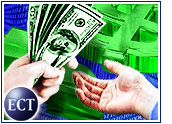
Take a look around Dot-Com Island. There isn’t an e-tail site still alive that hasn’t been affected by the recent shakeout to some degree. However, some of the Web merchants are more likely to survive than others.
The defining characteristics of those companies vary slightly, but one thing they all have in common is the potential to provide a return on investment for their shareholders.
After a careful look at all the players, analysts agree that eight companies have a great shot at beating the shakeout and making it into the final rounds. After the big three of eBay, Yahoo, and Amazon, analysts see multi-channel companies such as iQVC and JCPenney on top of the dot-com game.
And, like the hit TV series”Survivor,” the dot-com winner’s circle includes a few surprises.
1. eBay
With fourth-quarter financial results that convincingly beat analyst estimates and US$48.3 million earned in 2000, eBay is poised for continued spectacular growth.
Despite bumps along the road that have included service outages, disputes with users over making off-site deals, and fee structure changes, eBay’s business model and its first-to-market advantage put the company far ahead of its rivals.
Indeed, the company has so dominant a market share that many believe it has no real rivals. eBay’s fundamental strengths have led the company to rapid global expansion.
“They’ve created a brand that is stronger than the newspaper classifieds,” Gartner Group research director Robert Labatt told the E-Commerce Times. “They’ve globalized and regionalized the classifieds at the same time — that’s pretty powerful stuff.”
2. Yahoo
Like eBay, Yahoo does not have to deal with fulfilling orders or shipping products to buyers. The portal giant still expects a profit of between 33 cents to 43 cents per share in 2001, despite the current downturn in Net advertising sales.
Although the company’s shares have fallen along with the cooling economy, Yahoo is gradually trying to wean itself off its dependence on ad revenue.
Ranked the No. 1 shopping portal in December, Yahoo will survive as long as it continues its current trend of partnering with brick-and-mortars such as Circuit City and Target.
3. Amazon
Despite lowered revenue estimates for 2001, Amazon has been successful in trimming costs and staying on target for reaching profitability by the end of the year.
Amazon’s U.S. pro forma operating loss decreased from 24 percent of net sales in the fourth quarter of 1999 to less than 2 percent in the fourth quarter of 2000.
“They look to be in pretty decent shape as far as financial health and the drive to profitability, but they may not end up being as big as they had hoped,” said Morningstar.com stock analyst David Kathman.
4. iQVC
With strong customer service reviews and the No. 1 ranking in Forrester’s most recent general merchandise rankings, iQVC, the Internet arm of television powerhouse QVC, excels where so many other dot-coms have failed: delivery and distribution.
According to Gartner analyst Labatt, iQVC is successful because of a deep understanding of direct selling. Labatt commented that iQVC is “a strong contender” because of its background in catalog and television sales.
5. JCPenney.com
Like iQVC, JCPenney.com is able to draw on a history of shipping individual packages to people efficiently. Rather than relying solely on e-commerce, both companies use the Internet as an additional sales channel to enhance their business.
These companies do not care how people buy as long as people buy from one of their channels. Other Internet clothing merchants in that category include Eddie Bauer, J.Crew, and Lands’ End.
“The catalog to Web apparel companies will be successful because they already have the model,” Labatt said. “They’ve got an established brand, customer base, and distribution in place.”
6. Active.com
Active.com has captured the supply side of a unique million-dollar market: the registration and data management of services for participatory sports events, teams/leagues, and park activities. Through the company’s comprehensive database, users can find, learn about and register online for athletic events and activities.
“They provide activities that are a deep part of peoples’ lifestyles, and at the same time are things people pay for on an ongoing basis,” said Labatt.
Active.com is backed with $52 million in venture capital financing with strategic investments from Ticketmaster Online-City Search and a recent second funding round led by Deutsche Bank’s ABS Ventures.
“Active.com’s recent closing of second-round funding confirms that investors are still interested in consumer-oriented Internet business models that deliver utility, convenience, and revenue,” Labatt said.
7. Barnesandnoble.com
By merging its sales operations and inventories with its retail namesake late last year, Barnesandnoble.com may have successfully integrated its product inventories and distribution channels.
The move cut back on shipping costs and gives consumers more options for pickup, purchase and returns.
“They’ve stayed focused on their core competencies and grown that category,” Labatt said.
8. Travelocity
According to Forrester Research, online travel sales will skyrocket to US$29 billion by 2003, and Travelocity is in line to reap those rewards. Handily surpassing Wall Street expectations in its fourth-quarter revenue report, the company expects to reach profit status by this summer.
Boosted by its partnerships with America Online, Priceline.com, and AT&T, further consolidation efforts could ensure that Travelocity will continue to grow into profitability.




























































Social Media
See all Social Media